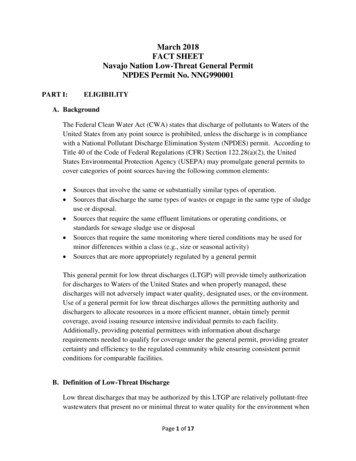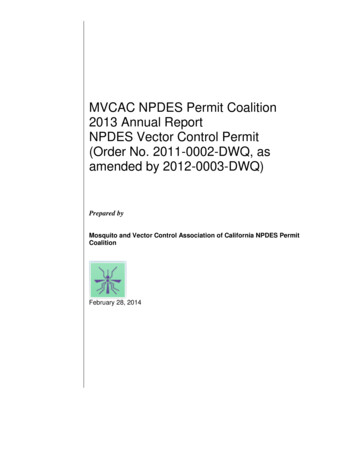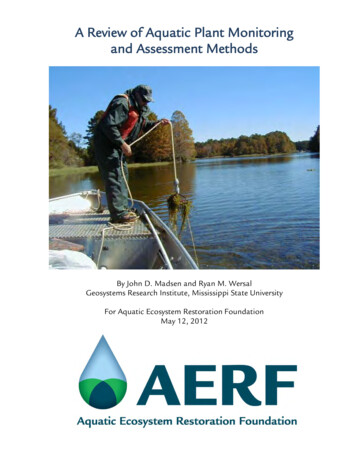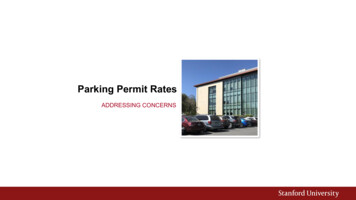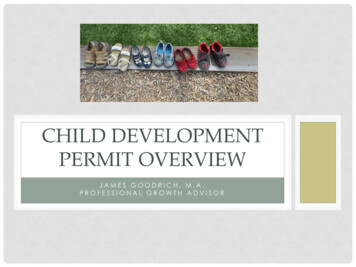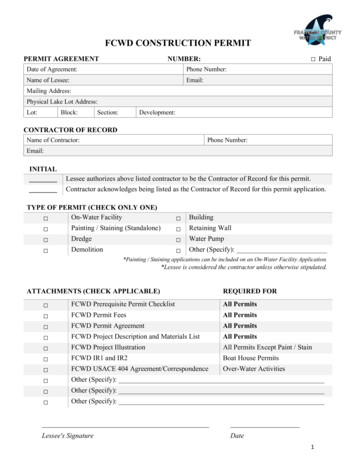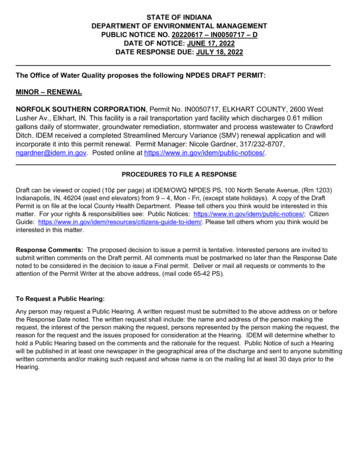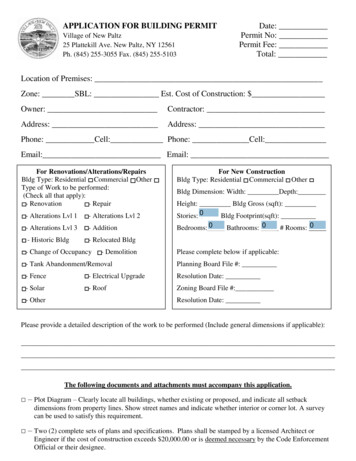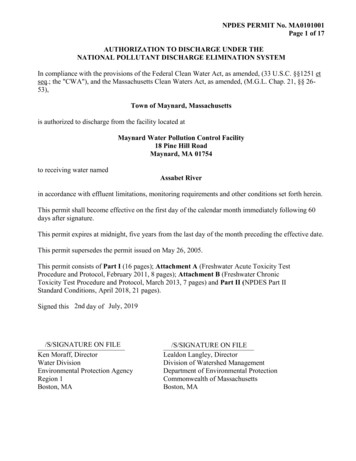
Transcription
NPDES PERMIT No. MA0101001Page 1 of 17AUTHORIZATION TO DISCHARGE UNDER THENATIONAL POLLUTANT DISCHARGE ELIMINATION SYSTEMIn compliance with the provisions of the Federal Clean Water Act, as amended, (33 U.S.C. §§1251 etseq.; the "CWA"), and the Massachusetts Clean Waters Act, as amended, (M.G.L. Chap. 21, §§ 2653),Town of Maynard, Massachusettsis authorized to discharge from the facility located atMaynard Water Pollution Control Facility18 Pine Hill RoadMaynard, MA 01754to receiving water namedAssabet Riverin accordance with effluent limitations, monitoring requirements and other conditions set forth herein.This permit shall become effective on the first day of the calendar month immediately following 60days after signature.This permit expires at midnight, five years from the last day of the month preceding the effective date.This permit supersedes the permit issued on May 26, 2005.This permit consists of Part I (16 pages); Attachment A (Freshwater Acute Toxicity TestProcedure and Protocol, February 2011, 8 pages); Attachment B (Freshwater ChronicToxicity Test Procedure and Protocol, March 2013, 7 pages) and Part II (NPDES Part IIStandard Conditions, April 2018, 21 pages).Signed this 2nd day of July, 2019/S/SIGNATURE ON FILEKen Moraff, DirectorWater DivisionEnvironmental Protection AgencyRegion 1Boston, MA/S/SIGNATURE ON FILELealdon Langley, DirectorDivision of Watershed ManagementDepartment of Environmental ProtectionCommonwealth of MassachusettsBoston, MA
NPDES Permit No. MA0101001Page 2 of 17PART IA. EFFLUENT LIMITATIONS AND MONITORING REQUIREMENTS1. During the period beginning on the effective date and lasting through the expiration date, the Permittee is authorized to dischargetreated effluent through Outfall Serial Number 001 to Assabet River. The discharge shall be limited and monitored as specifiedbelow; the receiving water and the influent shall be monitored as specified below.Effluent CharacteristicEffluent Flow6Effluent Flow6BOD5BOD5 RemovalTSSTSS RemovalpH Range7Total Residual Chlorine8,9Escherichia coli8.9Aluminum10,11Total Copper12Dissolved Oxygen(April 1 - October 31)Ammonia Nitrogen13(June 1 - October 31)Ammonia Nitrogen13(November 1 - May 31)AverageMonthly41.45 MGDRolling AverageReport MGD30 mg/L363 lb/day 85 %30 mg/L363 lb/day 85 %Effluent LimitationAverageMaximumWeeklyDailyMonitoring ----ContinuousRecorderReport MGDContinuousRecorderReport mg/L2/weekComposite---------Report mg/L2/weekComposite---73 μg/L--45 mg/L544 lb/day--45 mg/L544 lb/day--6.5 - 8.3 S.U.---126 μg/L--2/day2/day--GrabGrab126 cfu/100 mL---409 cfu/100 mL3/weekGrab274 μg/L0.037 mg/L-------0.053 kComposite1/weekComposite 5.0 mg/L12 mg/LReport lb/dayReport mg/LReport lb/day---Report, mg/L---Report mg/L
NPDES Permit No. MA0101001Page 3 of 17AverageMonthly4Report mg/LTotal Kjeldahl Nitrogen13Report lb/dayReport mg/LTotal Nitrate13Report lb/dayReport mg/LTotal Nitrite13Report lb/dayReport mg/LTotal Nitrogen13Report lb/dayTotal Phosphorus0.1 mg/L(April 1- October 31)Report lb/dayTotal Phosphorus0.2 mg/L(November 1- March 31)Report lb/dayWhole Effluent Toxicity (WET) Testing15,16LC50--C-NOEC--Hardness--Ammonia Nitrogen--Total Aluminum--Total Cadmium14--Total Copper--Total Nickel--Total Lead--Total Zinc--Total Organic Carbon--Effluent CharacteristicEffluent LimitationAverageMaximumWeeklyDailyMonitoring -Report mg/L1/quarterComposite---Report mg/L1/quarterComposite---Report mg/L1/quarterComposite---Report mg/L1/quarterComposite---Report mg/L3/weekComposite---Report mg/L1/weekComposite----------------------- 100 % 15 %Report mg/LReport mg/LReport mg/LReport mg/LReport mg/LReport mg/LReport mg/LReport mg/LReport te
NPDES Permit No. MA0101001Page 4 of 17Ambient Characteristic17,18HardnessAmmonia NitrogenTotal AluminumTotal Cadmium14Total CopperTotal NickelTotal LeadTotal ZincTotal Organic CarbonpH18Temperature18Influent ---------Reporting RequirementsAverageMaximumWeeklyDaily--Report mg/L--Report mg/L--Report mg/L--Report mg/L--Report mg/L--Report mg/L--Report mg/L--Report mg/L--Report mg/L--Report S.U.--Report CReporting lyReport mg/L----Report mg/L-----Monitoring g monthComposite2/monthComposite
NPDES Permit No. MA0101001Page 5 of 17Footnotes:1. Effluent samples shall yield data representative of the discharge. A routinesampling program shall be developed in which samples are taken at the samelocation, same time and same days of the week each month. The Permitteeshall report the results to the Environmental Protection Agency Region 1(EPA) and the State of any additional testing above that required herein, iftesting is in accordance with 40 C.F.R. Part 136.2. In accordance with 40 C.F.R. § 122.44(i)(1)(iv), the Permittee shall monitoraccording to sufficiently sensitive test procedures (i.e., methods) approvedunder 40 C.F.R. Part 136 or required under 40 C.F.R. chapter I, subchapter Nor O, for the analysis of pollutants or pollutant parameters (except WET). Amethod is “sufficiently sensitive” when: 1) The method minimum level (ML)is at or below the level of the effluent limitation established in the permit forthe measured pollutant or pollutant parameter; or 2) The method has thelowest ML of the analytical methods approved under 40 C.F.R. Part 136 orrequired under 40 C.F.R. chapter I, subchapter N or O for the measuredpollutant or pollutant parameter. The term “minimum level” refers to eitherthe sample concentration equivalent to the lowest calibration point in amethod or a multiple of the method detection limit (MDL), whichever ishigher. Minimum levels may be obtained in several ways: They may bepublished in a method; they may be based on the lowest acceptable calibrationpoint used by a laboratory; or they may be calculated by multiplying the MDLin a method, or the MDL determined by a laboratory, by a factor.3. When a parameter is not detected above the ML, the Permittee must report thedata qualifier signifying less than the ML for that parameter (e.g., 50 μg/L,if the ML for a parameter is 50 μg/L).4. In calculating and reporting the average monthly concentration when thepollutant is not detected, assign zero to the non-detected sample result if thepollutant was not detected for all monitoring periods in the prior twelvemonths. If the pollutant was detected in at least one monitoring period in theprior twelve months, then assign each non-detected sample result a value thatis equal to one half of the minimum level of detection for the purposes ofcalculating averages.5. Each composite sample will consist of at least twenty-four (24) grab samplestaken during one consecutive 24-hour period, either collected at equalintervals and combined proportional to flow or continuously collectedproportional to flow.6. Report annual average, monthly average, and the maximum daily flow inmillion gallons per day (MGD). The limit is an annual average, which shall bereported as a rolling average. The value will be calculated as the arithmetic
NPDES Permit No. MA0101001Page 6 of 17mean of the monthly average flow for the reporting month and the monthlyaverage flows of the previous eleven months.7. The pH shall be within the specified range at all times. The minimum andmaximum pH sample measurement values for the month shall be reported instandard units (S.U.).8. The Permittee shall minimize the use of chlorine while maintaining adequatebacterial control. Monitoring for total residual chlorine (TRC) is only requiredfor discharges which have been previously chlorinated, or which containresidual chlorine. For the purposes of this permit, TRC analysis must becompleted using a test method in 40 C.F.R. Part 136 that achieves a minimumlevel no greater than 20 μg/L. The compliance level for TRC is 20 μg/L.Chlorination and dechlorination systems shall include an alarm system forindicating system interruptions or malfunctions. Any interruption ormalfunction of the chlorine dosing system that may have resulted in levels ofchlorine that were inadequate for achieving effective disinfection, orinterruptions or malfunctions of the dechlorination system that may haveresulted in excessive levels of chlorine in the final effluent shall be reportedwith the monthly DMRs. The report shall include the date and time of theinterruption or malfunction, the nature of the problem, and the estimatedamount of time that the reduced levels of chlorine or dechlorination chemicalsoccurred.9. The monthly average limit for E. coli is expressed as a geometric mean. E.coli monitoring shall be conducted concurrently with TRC monitoring if TRCmonitoring is required.10. See Special Conditions, Part G11. Aluminum analysis must be completed using test method in 40 C.F.R. § 136that achieves a minimum level no greater than 87 µg/L.12. Copper analysis must be completed using a test method in 40 C.F.R. § 136that achieves a minimum level no greater than 3 µg/L.13. Ammonia nitrogen, total Kjeldahl nitrogen, total nitrate and nitrite nitrogensamples shall be collected concurrently. The results of these analyses shall beused to calculate both the concentration and mass loadings of total nitrogen(total nitrogen total Kjeldahl nitrogen total nitrate/nitrite nitrogen). Thetotal nitrogen loading values reported each quarter shall be calculated asfollows: Total Nitrogen (lb/day) [(average monthly total nitrogenconcentration (mg/L) * total monthly effluent flow (Million Gallon (MG))/#of days in the month] * 8.34.
NPDES Permit No. MA0101001Page 7 of 1714. Cadmium analysis must be completed using test method in 40 C.F.R. § 136that achieves the minimum level no greater than 2.0 µg/L.15. The Permittee shall conduct acute toxicity tests (LC50) and chronic toxicitytests (C-NOEC) in accordance with test procedures and protocols specified inAttachment A and B of this permit. LC50 and C-NOEC are defined in PartII.E. of this permit. The Permittee shall test the daphnid, Ceriodaphnia dubia,and the fathead minnow, Pimephales promelas. Toxicity test samples shall becollected and tests completed during the same weeks each time of calendarquarters ending March 31st, June 30th, September 30th, and December 31st. Thecomplete report for each toxicity test shall be submitted as an attachment tothe monthly DMR submittal immediately following the completion of the test.16. For Part I.A.1., Whole Effluent Toxicity Testing, the Permittee shall conductthe analyses specified in Attachment A and B, Part VI. CHEMICALANALYSIS for the effluent sample. If toxicity test(s) using the receivingwater as diluent show the receiving water to be toxic or unreliable, thePermittee shall follow procedures outlined in Attachment A and B, SectionIV., DILUTION WATER. Minimum levels and test methods are specified inAttachment A and B, Part VI. CHEMICAL ANALYSIS.17. For Part I.A.1., Ambient Characteristic, the Permittee shall conduct theanalyses specified in Attachment A and B, Part VI. CHEMICALANALYSIS for the receiving water sample collected as part of the WETtesting requirements. Such samples shall be taken from the receiving water ata point immediately upstream of the permitted discharge’s zone of influenceat a reasonably accessible location, as specified in Attachment A and B.Minimum levels and test methods are specified in Attachment A and B, PartVI. CHEMICAL ANALYSIS.18. A pH and temperature measurement shall be taken of each receiving watersample at the time of collection and the results reported on the appropriateDMR. These pH and temperature measurements are independent from any pHand temperature measurements required by the WET testing protocols.
NPDES Permit No. MA0101001Page 8 of 17Part I.A. continued.2. The discharge shall not cause a violation of the water quality standards of the receivingwater.3. The discharge shall be free from pollutants in concentrations or combinations that, in thereceiving water, settle to form objectionable deposits; float as debris, scum or other matter toform nuisances; produce objectionable odor, color, taste or turbidity; or produce undesirableor nuisance species of aquatic life.4. The discharge shall be free from pollutants in concentrations or combinations that adverselyaffect the physical, chemical, or biological nature of the bottom.5. The discharge shall not result in pollutants in concentrations or combinations in the receivingwater that are toxic to humans, aquatic life or wildlife.6. The discharge shall be free from floating, suspended and settleable solids in concentrations orcombinations that would impair any use assigned to the receiving water.7. The discharge shall be free from oil, grease and petrochemicals that produce a visible film onthe surface of the water, impart an oily taste to the water or an oily or other undesirable tasteto the edible portions of aquatic life, coat the banks or bottom of the water course, or aredeleterious or become toxic to aquatic life.8. The Permittee must provide adequate notice to EPA-Region 1 and the State of the following:a. Any new introduction of pollutants into the POTW from an indirect discharger whichwould be subject to Part 301 or Part 306 of the Clean Water Act if it were directlydischarging those pollutants or in a primary industry category (see 40 C.F.R. Part 122Appendix A as amended) discharging process water; andb. Any substantial change in the volume or character of pollutants being introduced into thatPOTW by a source introducing pollutants into the POTW at the time of issuance of thepermit.c. For purposes of this paragraph, adequate notice shall include information on:(1) The quantity and quality of effluent introduced into the POTW; and(2) Any anticipated impact of the change on the quantity or quality of effluent to bedischarged from the POTW.9. Pollutants introduced into the POTW by a non-domestic source (user) shall not pass throughthe POTW or interfere with the operation or performance of the works.
NPDES Permit No. MA0101001Page 9 of 17B. UNAUTHORIZED DISCHARGES1. This permit authorizes discharges only from the outfall listed in Part I.A.1, in accordancewith the terms and conditions of this permit. Discharges of wastewater from any other pointsources, including sanitary sewer overflows (SSOs), are not authorized by this permit inaccordance with Part II.D.1.e.(1) (24-hour reporting). See Part I.H below for reportingrequirements.2.Starting December 21, 2020, the Permittee must provide notification to the public within 24hours of any unauthorized discharge on a publicly available web site. Such notification shallinclude the location and description of the discharge; estimated volume; the period ofnoncompliance, including exact dates and times, and, if the noncompliance has not beencorrected, the anticipated time it is expected to continue.3. Notification of SSOs to MassDEP shall be made on its SSO Reporting Form (which includesMassDEP Regional Office telephone numbers). The reporting form and instruction for itscompletion may be found on-line at bypassbackup-notification.C. OPERATION AND MAINTENANCE OF THE SEWER SYSTEMOperation and maintenance (O&M) of the sewer system shall be in compliance with the StandardConditions of Part II and the following terms and conditions. The Permittee shall complete thefollowing activities for the collection system which it owns:1. Maintenance StaffThe Permittee shall provide an adequate staff to carry out the operation, maintenance, repair,and testing functions required to ensure compliance with the terms and conditions of thispermit. Provisions to meet this requirement shall be described in the Collection System O&MPlan required pursuant to Section C.5. below.2. Preventive Maintenance ProgramThe Permittee shall maintain an ongoing preventive maintenance program to preventoverflows and bypasses caused by malfunctions or failures of the sewer systeminfrastructure. The program shall include an inspection program designed to identify allpotential and actual unauthorized discharges. Plans and programs to meet this requirementshall be described in the Collection System O&M Plan required pursuant to Section C.5.below.3. Infiltration/InflowThe Permittee shall control infiltration and inflow (I/I) into the sewer system as necessary toprevent high flow related unauthorized discharges from their collection systems and highflow related violations of the wastewater treatment plant’s effluent limitations. Plans and
NPDES Permit No. MA0101001Page 10 of 17programs to control I/I shall be described in the Collection System O&M Plan requiredpursuant to Section C.5. below.4. Collection System MappingWithin 30 months of the effective date of this permit, the Permittee shall prepare a map of thesewer collection system it owns. The map shall be on a street map of the community, withsufficient detail and at a scale to allow easy interpretation. The collection system informationshown on the map shall be based on current conditions and shall be kept up-to-date andavailable for review by federal, state, or local agencies. Such map(s) shall include, but not belimited to the following:a. All sanitary sewer lines and related manholes;b. All combined sewer lines, related manholes, and catch basins;c. All combined sewer regulators and any known or suspected connections between thesanitary sewer and storm drain systems (e.g. combination manholes);d. All outfalls, including the treatment plant outfall(s), CSOs, and any known or suspectedSSOs, including stormwater outfalls that are connected to combination manholes;e. All pump stations and force mains;f. The wastewater treatment facility(ies);g. All surface waters (labeled);h. Other major appurtenances such as inverted siphons and air release valves;i. A numbering system which uniquely identifies manholes, catch basins, overflow points,regulators and outfalls;j. The scale and a north arrow; andk. The pipe diameter, date of installation, type of material, distance between manholes, andthe direction of flow.5. Collection System O&M PlanThe Permittee shall develop and implement a Collection System O&M Plan.a. Within six (6) months of the effective date of the permit, the Permittee shall submit toEPA and the State
NPDES Permit No. MA0101001Page 11 of 17(1) A description of the collection system management goals, staffing, informationmanagement, and legal authorities;(2) A description of the collection system and the overall condition of the collectionsystem including a list of all pump stations and a description of recent studies andconstruction activities; and(3) A schedule for the development and implementation of the full Collection SystemO&M Plan including the elements in paragraphs b.1. through b.8. below.b. The full Collection System O&M Plan shall be completed, implemented and submitted toEPA and the State within twenty-four (24) months from the effective date of this permit.The Plan shall include:(1) The required submittal from paragraph 5.a. above, updated to reflect currentinformation;(2) A preventive maintenance and monitoring program for the collection system;(3) Description of sufficient staffing necessary to properly operate and maintain thesanitary sewer collection system and how the operation and maintenance program isstaffed;(4) Description of funding, the source(s) of funding and provisions for funding sufficientfor implementing the plan;(5) Identification of known and suspected overflows and back-ups, including manholes.A description of the cause of the identified overflows and back-ups, corrective actionstaken, and a plan for addressing the overflows and back-ups consistent with therequirements of this permit;(6) A description of the Permittee’s programs for preventing I/I related effluent violationsand all unauthorized discharges of wastewater, including overflows and by-passesand the ongoing program to identify and remove sources of I/I. The program shallinclude an inflow identification and control program that focuses on thedisconnection and redirection of illegal sump pumps and roof down spouts;(7) An educational public outreach program for all aspects of I/I control, particularlyprivate inflow; and(8) An Overflow Emergency Response Plan to protect public health from overflows andunanticipated bypasses or upsets that exceed any effluent limitation in the permit.6. Annual Reporting RequirementThe Permittee shall submit a summary report of activities related to the implementation of itsCollection System O&M Plan during the previous calendar year. The report shall besubmitted to EPA and the State annually by March 31. The first annual report is due the firstMarch 31st following submittal of the collection system O&M Plan required by Part I.C.5.b.of this permit. The summary report shall, at a minimum, include:a. A description of the staffing levels maintained during the year;b. A map and a description of inspection and maintenance activities conducted andcorrective actions taken during the previous year;
NPDES Permit No. MA0101001Page 12 of 17c. Expenditures for any collection system maintenance activities and corrective actionstaken during the previous year;d. A map with areas identified for investigation/action in the coming year;e. A summary of unauthorized discharges during the past year and their causes and a reportof any corrective actions taken as a result of the unauthorized discharges reportedpursuant to the Unauthorized Discharges section of this permit; andf. If the average annual flow in the previous calendar year exceeded 80 percent of thefacility’s 1.45 MGD design flow (1.16 MGD), or there have been capacity relatedoverflows, the report shall include:(1) Plans for further potential flow increases describing how the Permittee will maintaincompliance with the flow limit and all other effluent limitations and conditions; and(2) A calculation of the maximum daily, weekly, and monthly infiltration and themaximum daily, weekly, and monthly inflow for the reporting year.D. ALTERNATE POWER SOURCEIn order to maintain compliance with the terms and conditions of this permit, the Permittee shallprovide an alternative power source(s) sufficient to operate the portion of the publicly ownedtreatment works it owns and operates, as defined in Part II.E.1 of this permit.E. INDUSTRIAL USERS1. The Permittee shall submit to EPA and the State the name of any Industrial User (IU) subjectto Categorical Pretreatment Standards under 40 C.F.R. § 403.6 and 40 C.F.R. chapter I,subchapter N (Parts 405-415, 417-436, 439-440, 443, 446-447, 454-455, 457-461, 463-469,and 471 as amended) who commences discharge to the POTW after the effective date of thispermit.This reporting requirement also applies to any other IU who discharges an average of 25,000gallons per day or more of process wastewater into the POTW (excluding sanitary,noncontact cooling and boiler blowdown wastewater); contributes a process wastewaterwhich makes up five (5) percent or more of the average dry weather hydraulic or organiccapacity of the POTW; or is designated as such by the Control Authority as defined in 40C.F.R. § 403.12(a) on the basis that the industrial user has a reasonable potential to adverselyaffect the wastewater treatment facility’s operation, or for violating any pretreatmentstandard or requirement (in accordance with 40 C.F.R. § 403.8(f)(6)).2. In the event that the Permittee receives reports (baseline monitoring reports, 90-daycompliance reports, periodic reports on continued compliance, etc.) from industrial userssubject to Categorical Pretreatment Standards under 40 C.F.R. § 403.6 and 40 C.F.R. chapterI, subchapter N (Parts 405-415, 417-436, 439-440, 443, 446-447, 454-455, 457-461, 463-
NPDES Permit No. MA0101001Page 13 of 17469, and 471 as amended), the Permittee shall forward all copies of these reports withinninety (90) days of their receipt to EPA and the State.F. SLUDGE CONDITIONS1. The Permittee shall comply with all existing federal and state laws and regulations that applyto sewage sludge use and disposal practices, including EPA regulations promulgated at 40C.F.R. Part 503, which prescribe “Standards for the Use or Disposal of Sewage Sludge”pursuant to § 405(d) of the CWA, 33 U.S.C. § 1345(d).2. If both state and federal requirements apply to the Permittee’s sludge use and/or disposalpractices, the Permittee shall comply with the more stringent of the applicable requirements.3. The requirements and technical standards of 40 C.F.R. Part 503 apply to the following sludgeuse or disposal practices:a. Land application - the use of sewage sludge to condition or fertilize the soilb. Surface disposal - the placement of sewage sludge in a sludge only landfillc. Sewage sludge incineration in a sludge only incinerator4. The requirements of 40 C.F.R. Part 503 do not apply to facilities which dispose of sludge in amunicipal solid waste landfill. 40 C.F.R. § 503.4. These requirements also do not apply tofacilities which do not use or dispose of sewage sludge during the life of the permit but rathertreat the sludge (e.g., lagoons, reed beds), or are otherwise excluded under 40 C.F.R. § 503.6.5. The 40 C.F.R. Part 503 requirements include the following elements: General requirementsPollutant limitationsOperational Standards (pathogen reduction requirements and vectorattraction reduction requirements)Management practicesRecord keepingMonitoringReportingWhich of the 40 C.F.R. Part 503 requirements apply to the Permittee will depend upon theuse or disposal practice followed and upon the quality of material produced by a facility. TheEPA Region 1 Guidance document, “EPA Region 1 - NPDES Permit Sludge ComplianceGuidance” (November 4, 1999), may be used by the Permittee to assist it in determining theapplicable requirements. 11 This guidance document is available upon request from EPA Region 1 and may also be found c/sludgeguidance.pdf
NPDES Permit No. MA0101001Page 14 of 176. The sludge shall be monitored for pollutant concentrations (all Part 503 methods) andpathogen reduction and vector attraction reduction (land application and surface disposal) atthe following frequency. This frequency is based upon the volume of sewage sludgegenerated at the facility in dry metric tons per year, as follows:less than 290290 to less than 1,5001,500 to less than 15,00015,000 1/ year1 /quarter6 /year1 /monthSampling of the sewage sludge shall use the procedures detailed in 40 C.F.R. § 503.8.7. Under 40 C.F.R. § 503.9(r), the Permittee is a “person who prepares sewage sludge” becauseit “is the person who generates sewage sludge during the treatment of domestic sewage ina treatment works .” If the Permittee contracts with another “person who prepares sewagesludge” under 40 C.F.R. § 503.9(r) – i.e., with “a person who derives a material from sewagesludge” – for use or disposal of the sludge, then compliance with Part 503 requirements is theresponsibility of the contractor engaged for that purpose. If the Permittee does not engage a“person who prepares sewage sludge,” as defined in 40 C.F.R. § 503.9(r), for use or disposal,then the Permittee remains responsible to ensure that the applicable requirements in Part 503are met. 40 C.F.R. § 503.7. If the ultimate use or disposal method is land application, thePermittee is responsible for providing the person receiving the sludge with notice andnecessary information to comply with the requirements of 40 C.F.R. § 503 Subpart B.8. The Permittee shall submit an annual report containing the information specified in the 40C.F.R. Part 503 requirements (§ 503.18 (land application), § 503.28 (surface disposal), or §503.48 (incineration)) by February 19 (see also “EPA Region 1 - NPDES Permit SludgeCompliance Guidance”). Reports shall be submitted electronically using EPA’s ElectronicReporting tool (“NeT”) (see “Reporting Requirements” section below).G. SPECIAL CONDITIONSAluminumThe effluent limit for total aluminum shall be subject to a schedule of compliance whereby thelimit takes effect three years after the effective date of the permit. 2 For the period starting on theeffective date of this permit and ending three (3) years after the effective date, the permittee shallreport only the monthly average aluminum concentration on the monthly DMR. After this initialthree (3) year period, the permittee shall comply with the monthly average total aluminum limitof 274 µg/L (“final effluent limit”). The permittee shall submit an annual report due by January15th of each of the first three (3) years of the permit that will detail its progress towards meetingthe final effluent limit.2 The final effluent limit of 274 µg/L for aluminum may be modified prior to the end of the three-year complianceschedule if warranted by the new criteria and a reasonable potential analysis, and if consistent with anti-degradationrequirements. Such a modification would not trigger anti-backsliding prohibition, as reflected in CWA § 402(o) and40 C.F.R. §122.44(l), provided that such modification is finalized before the final limit takes effect.
NPDES Permit No. MA0101001Page 15 of 17If during the three (3) year period after the effective date of the permit, Massachusetts adoptsrevised aluminum criteria, then the permittee may request a permit modification, pursuant to 40C.F.R
Town of Maynard, Massachusetts. is authorized to discharge from the facility located at . Maynard Water Pollution Control Facility. 18 Pine Hill Road. Maynard, MA 01754. to receiving water named . Assabet River . in accordance with effluent limitations, monitoring requirements and other conditions set forth herein.
